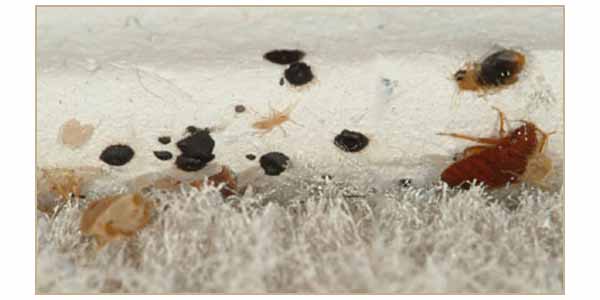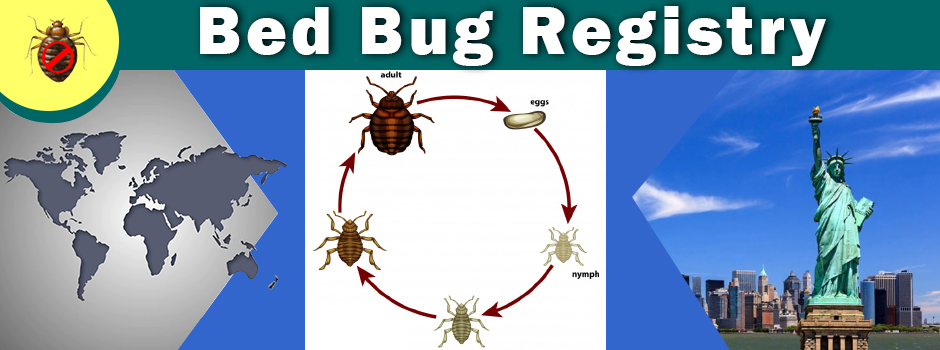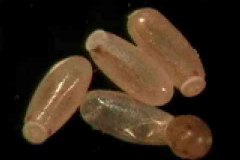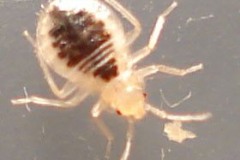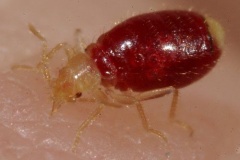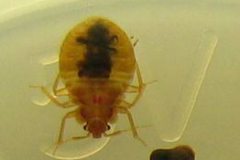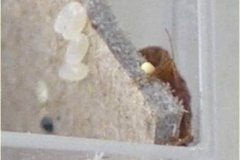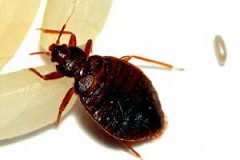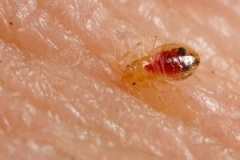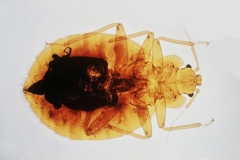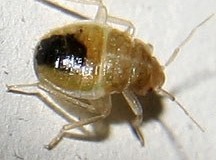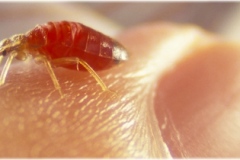Bed Bug Tape
 The easiest trapping method is to place double-sided carpet tape in long strips near or around the bed and check the strips after a day or more.
The easiest trapping method is to place double-sided carpet tape in long strips near or around the bed and check the strips after a day or more.
I got some carpet tape and some empty yoghurt containers. I put some masking tape over the containers incase the bed bugs can't climb up the bare plastic. I also sprayed a bit of hair spray on the masking tape to ensure some traction for the bed bugs. Then if you look at the far container, you will notice a white solid ring of carpet tape near the top. This is where I am hoping they will get stuck. Each bed leg will in one of these containers.
There is the option to isolate a bed using double-sided duct tape (also called carpet tape) to create the sticky barrier instead, although, carpet tape may be somewhat more expensive in length per foot than regular duct tape curled over'”something to consider if the taping method is used extensively. In any case, curled duct tape (with the sticky side out) can also be used in length on floors as a perimeter barrier to help quickly isolate or quarantine furniture (where it can span multiple feet on the floor around furniture or used to surround and isolate 'legless' beds with bases that are flush to the floor etc.).
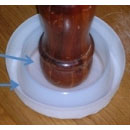 The technique can also be used to help prevent bed bugs from crawling up along walls where warranted. Long strips of this taping method (i.e. curled duct tape over painter's tape) can be used on standard floors to cordon off, surround, and isolate infested furniture, to protect clean furniture, or as part of a treatment effort to help prevent bed bugs from crawling toward specific areas. If used this extensively, it then becomes particularly more important to apply a protective layer of painter's tape first to prevent the duct tape from damaging and/or ruining painted surfaces or from leaving behind a sticky residue when finally pulled up. It should also be noted that the width of the painter's tape can be as narrow as one inch (which is typically less expensive per foot than wider versions of masking tape) since regular duct tape, though much wider initially, will fit within the one-inch width of the painter's tape'”after the duct tape has been curled over on itself lengthwise.
The technique can also be used to help prevent bed bugs from crawling up along walls where warranted. Long strips of this taping method (i.e. curled duct tape over painter's tape) can be used on standard floors to cordon off, surround, and isolate infested furniture, to protect clean furniture, or as part of a treatment effort to help prevent bed bugs from crawling toward specific areas. If used this extensively, it then becomes particularly more important to apply a protective layer of painter's tape first to prevent the duct tape from damaging and/or ruining painted surfaces or from leaving behind a sticky residue when finally pulled up. It should also be noted that the width of the painter's tape can be as narrow as one inch (which is typically less expensive per foot than wider versions of masking tape) since regular duct tape, though much wider initially, will fit within the one-inch width of the painter's tape'”after the duct tape has been curled over on itself lengthwise.

 Residence
Residence  Location
Location 

 Do bed bugs carry disease? Well, bed bugs carry 24 known pathogens, according to Baumann. Do bed bugs transmit disease? Nope, bed bug bites won't make you sick unless, of course, the bites get infected. Baumann says that the World Health Organization (WHO) conducted research in Africa which produced no documentation that the little ankle biters can transmit disease.
Do bed bugs carry disease? Well, bed bugs carry 24 known pathogens, according to Baumann. Do bed bugs transmit disease? Nope, bed bug bites won't make you sick unless, of course, the bites get infected. Baumann says that the World Health Organization (WHO) conducted research in Africa which produced no documentation that the little ankle biters can transmit disease. 
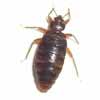 Bed bugs seem to possess all of the necessary prerequisites for being capable of passing diseases from one host to another, but there have been no known cases of bed bugs passing disease from host to host. There are at least twenty-seven known pathogens (some estimates are as high as forty-one) that are capable of living inside a bed bug or on its mouthparts. Extensive testing in laboratory settings concludes that bed bugs are unlikely to pass disease from one person to another. Therefore bed bugs are less dangerous than some more common insects such as the flea. Bed bugs cannot give you a disease like AIDS. This is one of the first things many people become worried about when they get bitten, which makes sense given how many things you hear you can get from other insects like mosquitoes. Bed bugs, however, won't transmit anything to you. They often have diseases inside them, but for whatever reason people don't catch them from a bed bug.
Bed bugs seem to possess all of the necessary prerequisites for being capable of passing diseases from one host to another, but there have been no known cases of bed bugs passing disease from host to host. There are at least twenty-seven known pathogens (some estimates are as high as forty-one) that are capable of living inside a bed bug or on its mouthparts. Extensive testing in laboratory settings concludes that bed bugs are unlikely to pass disease from one person to another. Therefore bed bugs are less dangerous than some more common insects such as the flea. Bed bugs cannot give you a disease like AIDS. This is one of the first things many people become worried about when they get bitten, which makes sense given how many things you hear you can get from other insects like mosquitoes. Bed bugs, however, won't transmit anything to you. They often have diseases inside them, but for whatever reason people don't catch them from a bed bug.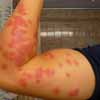 Since bedbugs are parasites that feed on human blood as well as feeding on blood of other mammals, asking ourselves whether bedbugs transmit diseases is only natural. After all, mosquitoes live off human blood and depending on the strain of mosquito; they transmit diseases such as malaria, encephalitis, and dengue fever. Fleas live off human blood as well as blood from other animals and they transmit bubonic plague. What's more, bedbugs do carry human viral and bacterial agents that can theoretically cause diseases. Bedbugs also carry protozoa and parasitic worms. In furtherance, bedbugs leave fecal droppings (spots) in areas they occupy. This includes mattresses, sheets, blankets, and could even include people's pajamas or body partsbed bugscrawl on.
Since bedbugs are parasites that feed on human blood as well as feeding on blood of other mammals, asking ourselves whether bedbugs transmit diseases is only natural. After all, mosquitoes live off human blood and depending on the strain of mosquito; they transmit diseases such as malaria, encephalitis, and dengue fever. Fleas live off human blood as well as blood from other animals and they transmit bubonic plague. What's more, bedbugs do carry human viral and bacterial agents that can theoretically cause diseases. Bedbugs also carry protozoa and parasitic worms. In furtherance, bedbugs leave fecal droppings (spots) in areas they occupy. This includes mattresses, sheets, blankets, and could even include people's pajamas or body partsbed bugscrawl on. 
 America is facing a bed bug outbreak of explosive proportions - and the resistance of the blood suckers to commonly usedpesticidesmeans there is no magical cure, public health and pest control experts warned today.
America is facing a bed bug outbreak of explosive proportions - and the resistance of the blood suckers to commonly usedpesticidesmeans there is no magical cure, public health and pest control experts warned today. "It's become a trajectory. We are at the point similar to the Aids virus where everyone knows someone who has had bed bugs or have had it themselves," said Dini Miller, the urban pest management specialist for the state of Virginia.
"It's become a trajectory. We are at the point similar to the Aids virus where everyone knows someone who has had bed bugs or have had it themselves," said Dini Miller, the urban pest management specialist for the state of Virginia.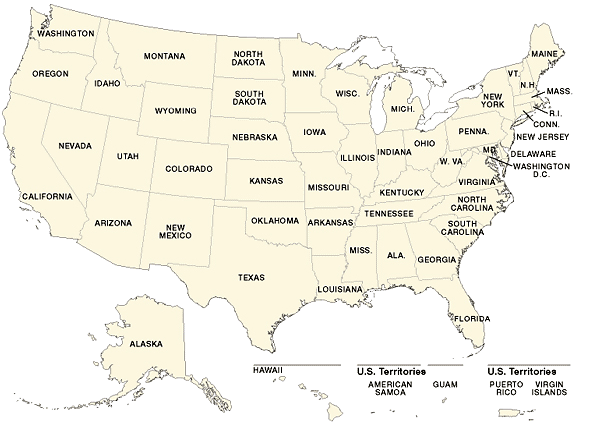
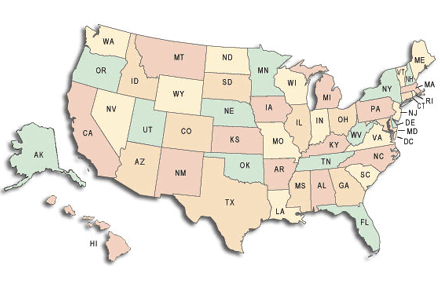
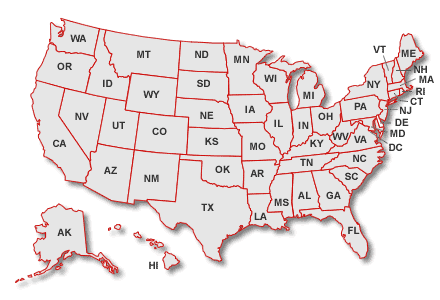
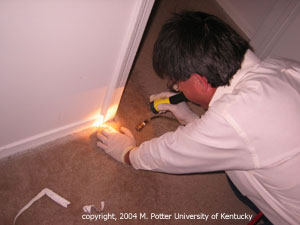
 General housecleaning measures, such as vacuuming floors and surfaces, seldom reaches the places where bed bugs hide. Targeted vacuuming of infested harborages, however, can help remove some of the bugs before treatment with insecticides. Bed bugs and especially the eggs can be difficult to dislodge. Optimum results will be achieved by moving and scraping the end of the suction wand along infested areas such as seams and fabric folds of beds and sofas, and the perimeter edge of wall-to-wall carpets. Afterward, dispose of the vacuum contents in a sealed trash bag. You must first locate where the bed bugs live. Remember, just because they are called bed bugs, doesn't mean they can't live in other areas of the home. Once the bed bugs are located, there are many control methods that may be used to combat the bed bugs. Vacuuming all visible bed bugs from the mattresses and box springs and their other known dwellings is an effective removal option. Ensure the vacuum bag is removed, sealed, and disposed of immediately after the vacuuming process. Mattresses and pillows can be cleaned, paying particular attention to the seams and ribbing of the mattress, to kill any remaining bed bugs. Seal the mattress and box springs in plastic bags to make sure any missed bugs do not attempt to escape. Bed linens and drapes can be dry cleaned or wet washed with a cleaning detergent and bleach in hot water.
General housecleaning measures, such as vacuuming floors and surfaces, seldom reaches the places where bed bugs hide. Targeted vacuuming of infested harborages, however, can help remove some of the bugs before treatment with insecticides. Bed bugs and especially the eggs can be difficult to dislodge. Optimum results will be achieved by moving and scraping the end of the suction wand along infested areas such as seams and fabric folds of beds and sofas, and the perimeter edge of wall-to-wall carpets. Afterward, dispose of the vacuum contents in a sealed trash bag. You must first locate where the bed bugs live. Remember, just because they are called bed bugs, doesn't mean they can't live in other areas of the home. Once the bed bugs are located, there are many control methods that may be used to combat the bed bugs. Vacuuming all visible bed bugs from the mattresses and box springs and their other known dwellings is an effective removal option. Ensure the vacuum bag is removed, sealed, and disposed of immediately after the vacuuming process. Mattresses and pillows can be cleaned, paying particular attention to the seams and ribbing of the mattress, to kill any remaining bed bugs. Seal the mattress and box springs in plastic bags to make sure any missed bugs do not attempt to escape. Bed linens and drapes can be dry cleaned or wet washed with a cleaning detergent and bleach in hot water.